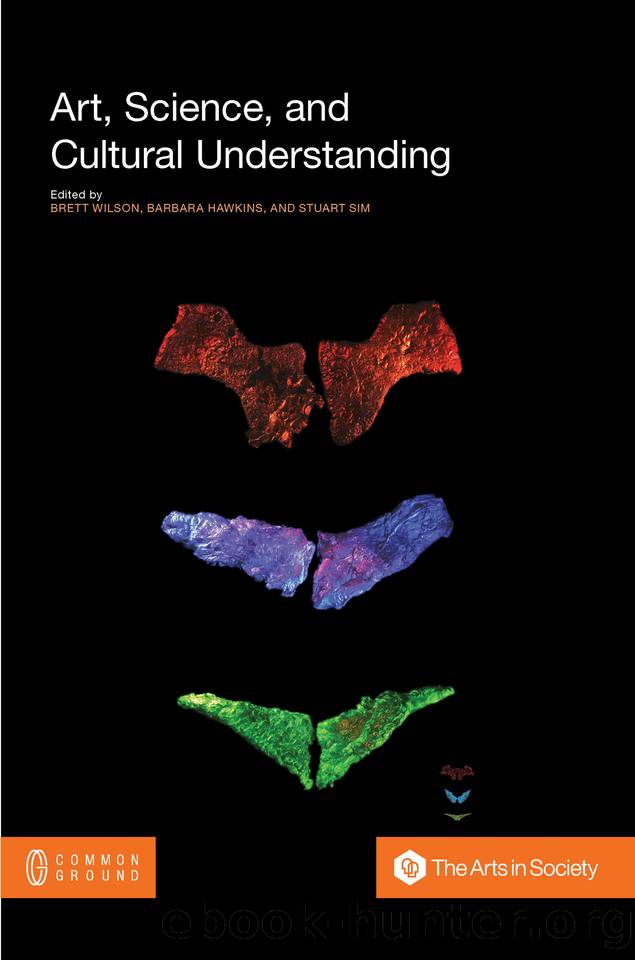Art, Science, and Cultural Understanding by Unknown

Author:Unknown
Language: eng
Format: epub
Publisher: Common Ground Publishing
Published: 2014-09-24T16:00:00+00:00
Figure 1: Henri Matisse , André Derain (1905).
Oil paint on canvas, 460 x 349 mm. Tate reference T00165.
Reproduced by permission of the Design and Artists Copyright Society.
Of course, Derain was by no means the first artist to consider the effect of illumination and appearance of coloured objects. Artists have a long history of investigating the properties of illumination and colour appearance through their paintings stretching back centuries. Indeed, skills such as colour matching from scene to substrate were considered the stock-in-trade of talented artists. However, in the last century, following the development of mathematical methods for representing colour relationships within a three-dimensional space, there has been a much greater reliance on measuring and plotting colour differences analytically. Paradoxically, now that computational colour science has reached a plateau of maturity, scientists have realised that localised measurements alone are not enough. To try and improve our understanding of colour perception and appearance, researchers in the field of high-dynamic-range (HDR) photography are now beginning to revisit and investigate the range of historical techniques artists have long employed to capture appearance and exploit colour perception.
Colour can usefully be considered as a meta-discipline that impacts on many different subjects and this chapter will consider how the art and science of colour has been explored and addressed by artists, theorists and scientists. It traces a path from Newtonian insights into single isolated colours (as one might view a colour through an aperture) to the perceptual and spatial insights into colour in general. We will also consider artists’ perceptions of colour appearance and how, through their fascination with natural and artificial illumination, they have investigated dynamic range and the juxtaposition of colours as tools for rendering the world through pigment.
A Brief Exploration of the Differences in Reproduction
Much scientific and technical energy has been invested in colour imaging and reproduction in the 21st century, and it has become a mature and highly sophisticated field. However, each new method for illuminating, looking at and reproducing pictures seems to bring with it a fresh set of problems. (Morovič 2008) Returning to Derrain’s portrait of Matisse by way of example, the primary method to appreciate artworks might be a visit the gallery to view the original, the second through printed reproduction either in a magazine, postcard or fine-art book, and the third is via the internet. However, the most expedient method to search for an image is probably in the reverse order: images can easily be sought on the internet, then as reproductions and finally as a pilgrimage to the gallery to look at the real artefact.
At the turn of the 20th century, when Derain painted Henri Matisse , the cost of a full colour reproduction would have been extremely prohibitive and art lovers would have had to be satisfied with a black and white reproduction, or if lucky, a few special colour plates that were separately glued into the book. As Edgar Wind described reproductions of the time:
Since the ordinary photographic plate is sensitive to a larger range of shades
Download
This site does not store any files on its server. We only index and link to content provided by other sites. Please contact the content providers to delete copyright contents if any and email us, we'll remove relevant links or contents immediately.
Kathy Andrews Collection by Kathy Andrews(11765)
The remains of the day by Kazuo Ishiguro(8891)
Spare by Prince Harry The Duke of Sussex(5140)
Paper Towns by Green John(5136)
The Body: A Guide for Occupants by Bill Bryson(5027)
Industrial Automation from Scratch: A hands-on guide to using sensors, actuators, PLCs, HMIs, and SCADA to automate industrial processes by Olushola Akande(5024)
Machine Learning at Scale with H2O by Gregory Keys | David Whiting(4258)
Be in a Treehouse by Pete Nelson(3996)
Never by Ken Follett(3882)
Harry Potter and the Goblet Of Fire by J.K. Rowling(3808)
Goodbye Paradise(3761)
Into Thin Air by Jon Krakauer(3348)
The Remains of the Day by Kazuo Ishiguro(3346)
Fairy Tale by Stephen King(3307)
The Cellar by Natasha Preston(3297)
The Genius of Japanese Carpentry by Azby Brown(3254)
120 Days of Sodom by Marquis de Sade(3226)
The Man Who Died Twice by Richard Osman(3040)
Drawing Shortcuts: Developing Quick Drawing Skills Using Today's Technology by Leggitt Jim(3037)
